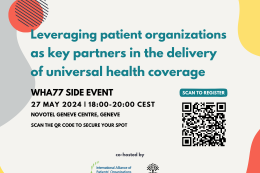How to build a global network

First published 6 July 2015. Updated 30 June 2016.
Main objectives
Rare Diseases International (RDI) is a global alliance of patients and families of all nationalities across all rare diseases. It is the voice of an estimated 280 million people living with rare diseases around the world today. As such, it works to give visibility to rare diseases in the global health agenda. The main objectives of the global alliance are:
- To promote rare diseases as an international public health and research priority through public awareness and policy-making
- To represent members and people living with rare diseases at large and in international institutions and forums, such as the World Health Organization (WHO) and the United Nations Economic and Social Council (ECOSOC)
- To enhance the capacities of members through information, exchange, networking, mutual support and joint actions
RDI was formally launched on 28 May 2015 immediately after the EURORDIS Membership Meeting in Madrid, Spain.
Lessons learnt
Building an international network can be a slow process and usually takes longer than initially expected. However, it is better to take the time necessary to set up a solid foundation in order to have a maximum chance of success. In the case of RDI, the initial focus is on taking action with recognised results and gaining experience of working together.
The preliminary phase of the initiative has been steered by EURORDIS and a core group of umbrella organizations that have a solid track record and reflect the type of membership RDI seeks to attract (ie. national alliances of rare disease patient organizations, regional networks and disease-specific cross-border federations).
To date, the national alliances of the US (NORD), Canada (CORD), Japan (JPA), China (CORD), India (I-ORD), the Ibero-American Pan Regional Alliance (ALIBER) and the International Federation for Epidermolysis Bullosa (DEBRA International) are part of an interim steering committee that will act as the governing body until a Council of RDI is elected in May 2016.
Assets and Challenges
One of the key assets of RDI is that it hasn't started from scratch. It builds on the success of EURORDIS, the largest European alliance of rare disease patient organizations, which has progressively drawn an increasing number of patient groups from outside of Europe through its international activities. One such international activity is Rare Disease Day, an awareness campaign that has expanded its reach from a few European countries in 2008 to more than 80 countries from around the world in 2015.
Moreover, RDI is presently embedded in one solid organization that is able to ensure minimal funding, one salaried employee dedicated entirely to setting up the network and access to support services.
The key challenge is to speak with one voice and to unite a large number of organizations around common principles throughout regions and countries of the world, which are at very different stages of economic development.
Top tips for success
- Start by securing partnerships with a core group of organizations that share the same vision, have the same level of commitment and time to dedicate to the endeavour.
- Test the concept for a year by presenting the idea of the initiative at various meetings and conferences. Encourage the core group to disseminate the idea through their membership and networks.
- Define membership criteria and governance methods from the start. Allow flexibility in order to accommodate organizational models that are different from the ones you are familiar with in your part of the world.
- Allocate an initial budget for meetings and travel, especially in pre-launch and launch period. Fellowships to attend meetings can help to bring in patient representatives from further afield.
- Piggyback on conferences and meetings that attract your target audience. Organizing your meetings back to back to existing conferences or as satellite meetings can help leverage logistics for organizers and travel costs for participants.
- Seek to diversify funding and establish indicators from the beginning in order to build credibility and ensure long-term sustainability.



